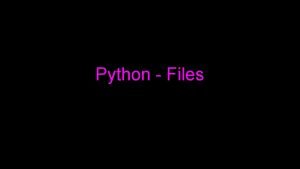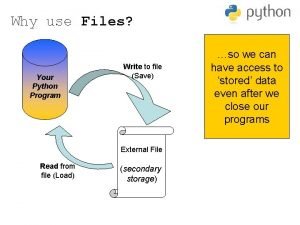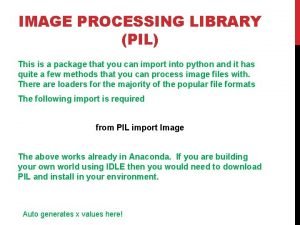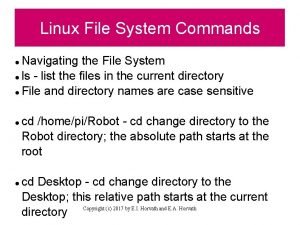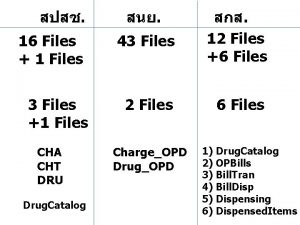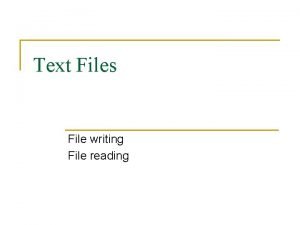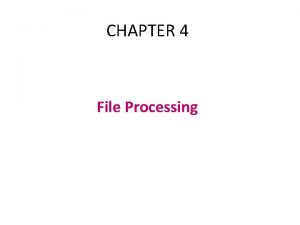Python Files File Processing A text file can



















- Slides: 19

Python - Files

File Processing -- A text file can be thought of as a sequence of lines From jeromitc@umail. iu. edu Wed Jun 10 09: 14: 16 2015 Return-Path: <postmaster@umail. iu. edu> Date: Wed Jun 10 09: 14: 16 2015 To: jasmith@gmail. com From: jeromitc@umail. iu. edu Subject: Hello! Details: How are you?

Opening a File -- Before reading the contents of a file, Python needs to know the file and the operation on that file -- This is done with the open() function -- open() returns a “file handle” - a variable used to perform operations on the file -- Kind of like “File -> Open” in a Word Processor

Using open() handle = open(filename, mode) fhand = open('mbox. txt', 'r') -- returns a handle use to manipulate the file -- filename is a string -- mode is optional and should be 'r' if reading from the file and 'w' if writing to the file. http: //docs. python. org/lib/built-in-funcs. html

What is a Handle? >>> fhand = open('mbox. txt') >>> print fhand <open file 'mbox. txt', mode 'r' at 0 x 1005088 b 0>

When Files are Missing >>> fhand = open('stuff. txt') Traceback (most recent call last): File "<stdin>", line 1, in <module>IOError: [Errno 2] No such file or directory: 'stuff. txt'

The newline Character -- Use the "newline" character to indicate when a line ends -- It is represented as a n in strings -- Newline is still one character not two >>> stuff = 'Hellon. World!’ >>> print stuff Hello World! >>> stuff = 'Xn. Y’ >>> print stuff X Y >>> len(stuff) 3

File Processing -- A text file can be thought of as a sequence of lines From jeromitc@umail. iu. edu Wed Jun 10 09: 14: 16 2015 Return-Path: <postmaster@umail. iu. edu> Date: Wed Jun 10 09: 14: 16 2015 To: jasmith@gmail. com From: jeromitc@umail. iu. edu Subject: Hello! Details: How are you?

File Processing -- A text file has newlines at the end of each line From jeromitc@gmail. com Sat Jan 5 9: 14: 16 2015n Return-Path: <postmaster@collab. githubproject. org>n Date: Sat, 5 Jan 2008 09: 12: 18 -0500n. To: source@collab. githubproject. orgn. From: jeromitc@gmail. comn. Subject: [github] svn commit: r 39772 content/branches/n. Details: http: //source. githubproject. org/viewsvn/? view=rev&rev=39772n

File Handle as a Sequence -- A file handle open for read can be treated as a sequence of strings where each line in the file is a string in the sequence -- Use the for statement to iterate through a sequence -- Remember - a sequence is an ordered set xfile = open('mbox. txt') for cheese in xfile: print cheese

Counting Lines in a File -- Open a file read-only -- Use a for loop to read each line -- Count the lines and print out the number of lines fhand = open('mbox. txt') count = 0 for line in fhand: count = count + 1 print 'Line Count: ', count $ python open. py Line Count: 132045

Searching Through a File -- An if statement can be used in the for loop to only print lines that meet some criteria fhand = open('mbox-short. txt') for line in fhand: if line. startswith('From: ') : print line

OOPS! What are all these blank lines doing here? From: micheal. jefferson@ecsu. edu From: louis@berkeley. edu From: zqian@standford. edu From: rjlowe@iupui. edu. . .

OOPS! What are all these blank lines doing here? Each line from the file has a newline at the end. The print statement adds a newline to each line. From: micheal. jefferson@ecsu. edun n From: louis@berkeley. edun n From: zqian@standford. edun n From: rjlowe@iupui. edun n. . .

Searching Through a File (fixed) -- We can strip the whitespace from the right hand side of the string using rstrip() from the string library -- The newline is considered "white space" and is stripped fhand = open('mbox-short. txt') for line in fhand: line = line. rstrip() if line. startswith('From: ') : print line From: micheal. jefferson@ecsu. edu From: louis@berkeley. edu From: zqian@standford. edu From: rjlowe@iupui. edu. .

Skipping with continue …Convienently skip a line by using the continue statement fhand = open('mbox-short. txt') for line in fhand: line = line. rstrip() if not line. startswith('From: ') : continue print line

Using in to select lines -- We can look for a string anywhere in a line as our selection criteria fhand = open('mbox-short. txt') for line in fhand: line = line. rstrip() if not '@gmail. com' in line : continue print line From jeromitc@gmail. com Sat Jan 5 09: 14: 16 2008 X-Authentication-Warning: set sender to jeromitc@gmail. com using –f From: jeromitc@gmail. com. Author: jeromitc@gmail. com From jane. doe@gmail. com Fri Jan 4 07: 02: 32 2008 X-Authentication-Warning: set sender to jane. doe@gmail. com using -f. . .

fname = raw_input('Enter the file name: ') fhand = open(fname) count = 0 for line in fhand: if line. startswith('Subject: ') : count = count + 1 print 'There were', count, 'subject lines in', fname Prompt for File Name Enter the file name: mbox. txt There were 1697 subject lines in mbox. txt Enter the file name: mbox-short. txt There were 17 subject lines in mbox-short. txt

Bad File Names fname = raw_input('Enter the file name: ') try: fhand = open(fname) except: print 'File cannot be opened: ', fname exit() count = 0 for line in fhand: if line. startswith('Subject: ') : count = count + 1 print 'There were', count, 'subject lines in', fname Enter the file name: mbox. txt There were 1697 subject lines in mbox. txt Enter the file name: na na boo File cannot be opened: na na boo
 Python text file processing
Python text file processing File mode python
File mode python Ncic restricted files list
Ncic restricted files list Cjis meaning
Cjis meaning Making connections images
Making connections images Open python files
Open python files File-file yang dibuat oleh user pada jenis file di linux
File-file yang dibuat oleh user pada jenis file di linux What does a markup tag tells the web browser
What does a markup tag tells the web browser Audio processing in python
Audio processing in python Python image processing library
Python image processing library Python file system commands
Python file system commands Top down vs bottom up processing
Top down vs bottom up processing Bottom up processing vs top down processing
Bottom up processing vs top down processing Bottom up and top down processing
Bottom up and top down processing High boost filtering matlab
High boost filtering matlab Secondary food processing
Secondary food processing Point processing operations in image processing
Point processing operations in image processing Histogram processing in digital image processing
Histogram processing in digital image processing Parallel processing vs concurrent processing
Parallel processing vs concurrent processing A generalization of unsharp masking is
A generalization of unsharp masking is
